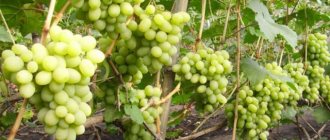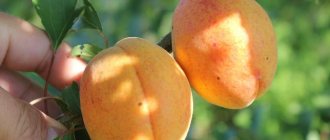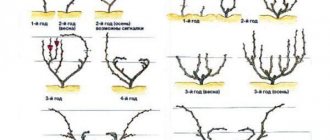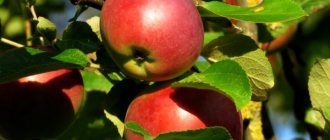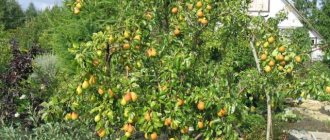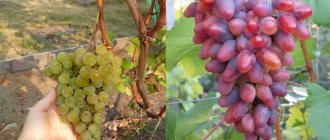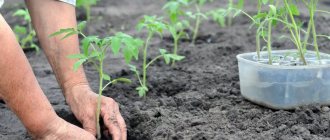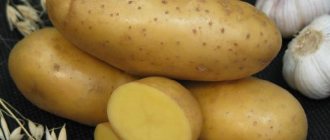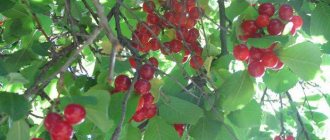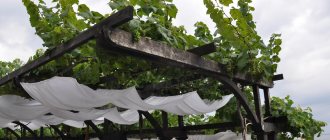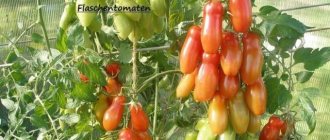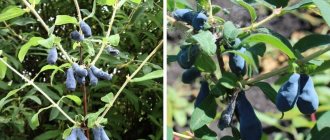Description of culture
The plant can reach 4-4.5 meters in height, the crown of the tree is spreading, which greatly facilitates the process of collecting fruits. The apricot root system is powerful, so you need to ensure that the roots do not protrude above the ground.
In appearance, Russian is practically no different from other apricot varieties. The bark on young shoots has a characteristic red-brown tint and many lentils. The leaves are round in shape, slightly elongated towards the apex, and have a finely toothed edge.
Apricot flowers are single, the petals are white or pink with reddish veins. The flowers bloom before the leaves appear.
The variety is characterized by large, slightly flattened yellow-orange fruits. The weight of one apricot can reach 60-65 g. The pulp of the fruit is juicy, aromatic, and easily separated from the stone.
The frost resistance of the Rossiyanin variety allows the crop to be grown in central regions, including the Moscow region, Ryazan and Samara regions.
Description of the apricot variety Russian
The variety in question is the result of the work of breeders of the North Caucasus Research Institute of Horticulture and Viticulture. Scientists pursued the goal of obtaining a crop that would be able to withstand temperature changes and sudden changes in weather conditions. The result was successfully achieved. Russian is a seedling from free pollination of the “P-3-1” form. The culture has been undergoing state testing since 1985.
The life form of the plant is a tree; for apricot it is not tall - from 3.5 to 4 m. The crown is lush and spreading, which makes harvesting easier and eliminates the need to form a crown. The foliage of the branches is average, the shoot-forming ability is high. The leaf blades are bright green in color, have an elongated shape, with a sharp tip.
Did you know? Due to the fact that apricots came to Europe through Armenia, they were called “Armenian apples” for a long time.
The edge is finely toothed. The bark of young specimens is red-brown, smooth, with multiple lentils. With age, the bark becomes cracked and acquires a brownish-gray tint. The fruits are large, bright orange in color, with a pronounced ventral seam. The weight of one reaches 50 g. The peel is medium-dense and pubescent. The pulp is orange, fleshy, juicy. The taste is sweet, with a subtle sourness.
Characteristics
Characteristics of the Russian apricot variety has several features. First of all, the crop is distinguished by its ability to tolerate unfavorable conditions of the region in which it grows, and also has immunity to a wide range of diseases and pests.
Drought resistance, winter hardiness
The frost-resistant Russian apricot variety can tolerate temperatures down to minus 30-33 °C. The crop's resistance to dry periods is average. For favorable growth of apricot, it needs to be provided with proper watering.
Pollination, flowering period and ripening time
The variety is a self-fertile crop, but to increase productivity, it is better to plant pollinators nearby for the Russian apricot. These are, first of all, other apricot varieties that have similar flowering periods. The tree begins to bloom in May, and the fruits ripen in mid-July.
Productivity, fruiting
One of the main advantages of the Russian variety is its high yield rates. From one mature tree you can collect more than 70 kg of fruit. At the same time, the fruits ripen very large and juicy.
The harvest can be harvested starting from the 3-4th year after planting the seedling in a permanent place. Regular pruning of the tree will increase the yield.
Area of application of fruits
Apricot fruits of the Russian variety have excellent taste. They are ideal for both fresh consumption and for making various preparations.
Attention! Apricot preparations are an excellent way to preserve healthy and tasty fruits for the winter. The Russian variety is suitable for making preserves, jams and syrups.
Resistance to diseases and pests
The variety is resistant to most pests and diseases that affect stone fruits, and apricots in particular.
Advantages and disadvantages
The main advantages of the Russian variety are:
- high productivity;
- large and juicy fruits;
- resistance to frost, drought and parasites;
- self-fertility.
This culture has practically no disadvantages. However, the variety does not tolerate stagnant moisture in the soil.
Advantages and disadvantages
The Russian is a very unpretentious and easy to grow apricot variety; the tree takes root easily and can develop independently. However, it is worth considering that the lack of proper care will certainly affect the quantity of the harvest and the quality of the fruit. It is better to choose seedlings from local nurseries, as they are already adapted to certain climatic conditions. Main advantages:
- productivity (even in years with unfavorable weather);
- frost resistance;
- self-fertility;
- good drought resistance;
- the crown is convenient for harvesting;
- excellent immunity to diseases and pests;
- excellent taste and marketability of fruits, keeping quality and transportability.
Attention!
The Russian variety easily tolerates winters with sharply changing thaws and colds; summer temperature changes are also not scary for it.
Like other apricot trees, Russian does not grow in areas with poor, heavy soils and high groundwater levels, as well as in wetlands and lowlands. Another disadvantage is early flowering; return frosts can damage some of the fruit buds or buds, which will affect the amount of harvest. If the winter temperature drops to 35–40˚C for a long time, there is a risk of roots freezing, the yield will decrease, but only for one season.
Landing Features
Growing Russian apricots in the middle zone requires compliance with a number of conditions. It is important to choose the optimal place for the seedling, as well as determine the timing of planting.
Recommended timing
It is best to plan apricot planting in the middle - end of April. By this time, the soil will have warmed up enough and the root system will not be damaged by frost.
Choosing a suitable location
Successful cultivation of Russian apricots also depends on the planting location. The selected area should be sufficiently illuminated, but at the same time protected from north winds by some kind of building or fence. The level of groundwater is not of great importance for the Russian variety.
What crops can and cannot be planted next to apricots?
An adult tree, due to its spreading branches and powerful roots, takes up quite a lot of space and creates a large shadow. Therefore, only early spring flowers, such as tulips or daffodils, can be planted next to apricots.
Undesirable neighbors for apricots are raspberries and currants. Also, you should not plant the crop in a place where other stone fruit trees previously grew.
Selection and preparation of planting material
You should purchase seedlings from trusted nurseries. Planting material should not show signs of disease, the root system and shoots should be intact, without breaks, cracks or damage. No preparation of apricot seedlings is required, but if desired, the root system can be treated with mullein solution.
Landing algorithm
The main stages of planting apricot Russian:
- In the fall, you need to dig a hole, the size of which is 70 cm deep and about 75 cm wide.
- A layer of crushed stone or pebbles is placed at the bottom of the pit. Clay performs the drainage function for sandy soils.
- The top layer of dug soil must be mixed with humus, compost and ash, and then a complex of mineral fertilizers must be added.
- The hole is filled to the top with the prepared substrate, a stake is driven in, and a seedling is placed on top of the ground.
- It is necessary to fill the apricot root system and form a hill, compacting the soil.
- The seedling is tied to a peg. A roller is formed around the plant, which is necessary to retain water.
At the end, you need to water the apricot with 10-15 liters of water.
Varieties of self-fertile apricots
Most self-fertile apricots are precocious
One of the first self-fertiles we had was Northern Triumph (planted in the spring). They chose it for the reason that they really wanted apricots, but the seedlings were a little expensive, and they dreamed of planting other trees. But it was not possible to check it for self-fertility - in the fall of the same year, Saratov ruby, another variety with an unknown name from friends from Rossosh, appeared on the site.
The first fruits appeared simultaneously on all trees after 4 years. Perhaps the harvest would have been earlier, for example, on Triumph, but in past years there were return frosts in April, and we attribute the lack of ovaries in the 3rd year to this. This year (the 6th year of tree growth) there were a lot of apricots, but this was also an “apricot” year, despite the moniliosis that appeared in late spring.
The diverse assortment of the State Register of the Russian Federation and the All-Russian Scientific Institute VNIISPK offers a choice of several self-fertile varieties of apricots. In foreign selection and amateur gardening, there are almost a dozen time-tested self-fertile cultivars with good yields, suitable for cultivation in different regions of our country.
The old Soviet variety of apricot is designed to grow in the Caucasus and the Volga region, but has spread throughout central Russia. It ripens early - in early July, and the harvest ripens unevenly. A bright pink blurry blush is always present on the fruits; it is especially pronounced on the “sunny” side of the apricot. The fruits weigh up to 45–50 g.
Red-cheeked - self-fertile, worthy of attention
Orlovchanin
This variety is partially self-fertile - the absolute lack of pollination reduces the yield of the cultivar. Orlovchanin is a mid-season apricot intended for cultivation in the Black Earth and Volga regions; the variety feels good in Belarus. In the 3rd year after planting, you can already taste the first fruits of the cultivar: ovoid, orange-yellow, weighing up to 33 g, with slight pubescence, sweet and sour, the pulp is loose, easily separated from the seed. The Oryol resident is not afraid of klyasterosporiosis and is capable of producing an average of up to 147 c/ha.
Orlovchanin - frost-resistant variety
Pearl of Zhiguli
According to VNIISPK, this is a partially self-fertile apricot variety that ripens on the 20th of July. This tree is ready to bear its first harvest in the 4th year. The fruits of the cultivar are slightly elongated (weight 20 g), covered with yellow skin with reddish spots; the pulp is loose, bright orange, somewhat dry, but sweet. Gardeners include good winter hardiness of the variety, excellent resistance of flower buds to spring frosts (up to -7 degrees), and relatively good transportability.
Apricot Zhemchuzhina Zhiguli is capable of producing up to 26 kg from one tree in the 6th–7th year of growth
Black velvet
The dark-fruited hybrid of apricot and cherry plum is partially self-fertile (according to the Michurinsk Gardeners Association). The first harvest ripens already in the 3rd year. A cultivar tree with a powerful crown, the fruits are medium-sized (weight 30 g), but quite tasty: sweet, aromatic, dark purple, slightly pubescent. The variety's harvest ripens at the end of July - it is a mid-early apricot.
Apricot is a heat-loving crop, but we have learned to grow it even in Siberia and the Urals
It is difficult to determine the characteristics of self-fertile apricots, in addition to their varietal characteristics regarding fruiting without pollination. All agricultural technology for self-fruits differs little from the care of conventional cultivars from this category of fruits. Apricots are planted on the sunny side of the site, preferably on the south or southeast.
The peculiarities of the culture lie in the observance of agricultural technology.
- Apricots require annual sanitary and formative pruning.
- Abundant but infrequent watering is the key to the longevity of the tree (from 15 to 40 liters of water, depending on the age of the tree and the weather).
- Apricot requires periodic feeding: in early spring - urea or superphosphate (15-20 g in the trunk circle); during the fruiting period - complex mineral fertilizers according to the instructions; after fruiting - in mid-August - the tree trunk circle is filled with humus and shed with water, then mulched; in the fall - water with a solution of phosphorus-potassium fertilizer (15–20 g per bucket of water).
- This crop needs to regulate fruiting - the ovaries are partially removed, especially with abundant flowering.
- Prevention of moniliosis and other fungal and bacterial diseases is absolutely necessary for apricots (treatment with Skor, Horus, etc. according to the instructions).
Selection does not stand still: every year new varieties of apricots appear in amateur gardening, some of which are self-fertile. They deserve attention especially when the garden plot is small and does not involve growing a large number of trees. Among such cultivars there are frost-resistant ones, with different types of crowns, and immunoresistant ones. And, importantly, fruits with different taste characteristics are a worthy choice. And self-fertile apricots will not let you down in terms of yield.
Based on the description of the variety, we can conclude that in appearance the fruits of this apricot are practically no different from other varieties. They are large in weight (minimum about 76 grams), round, slightly flattened in shape.
The pulp is tasty, sweet with a slight sourness. The more sunlight that hits the fruit, the sweeter it is. Fruits of this variety are always a rich, bright yellow color with pinkish “cheeks.” The aroma is well expressed.
A small disadvantage of the variety is that Russian apricots are usually eaten only fresh. They are not suitable for preservation or any other processing.
Apricots of the Russian variety are consumed only fresh
History of selection
Subsequent care of the crop
Many reviews about the Russian apricot contain information that the culture is completely unpretentious in care, and this is true. You need to water the apricot early in the morning or after sunset and make sure that water does not stagnate around the tree. Since the variety tolerates drought well, 1-2 times a week will be enough.
Apricot feeding is carried out according to the following scheme:
- before planting, fertilizers are applied three times with an interval of 10-14 days;
- starting from the second year of the plant’s life, mineral fertilizers are applied every year in spring and autumn;
- Organic fertilizers are best used no more than once every 4 years.
To increase productivity, you need to prune the crown every spring. In this case, all shoots are shortened by half, and only 5-7 main skeletal branches remain. In the fall, sanitary pruning is carried out, as a result of which all damaged, broken or diseased shoots are removed.
Preparing apricots for the coming winter involves removing all weeds, digging up the soil and spraying with insecticidal preparations. To protect against rodents, it is recommended to cover the trunk and lower shoots with spruce branches.
Reviews
Maria
Over the course of 15 years, I managed to try 6 different varieties of apricot, which have excellent winter hardiness; I liked the Russian one the most. Its fruits, unlike others, are large and very sweet and aromatic. The taste, as I noticed, is slightly lost after drying and heat treatment, but remains good. For 3 years I covered the trunk, for the fourth year it was not possible to get out to the dacha in the fall, and in the spring the tree bloomed. To prevent the tree from becoming depleted, I removed 90% of the flowers, and in the second and third seasons I cut off 50% of the greens. Now I don’t carry out normalization; the tree is 8 years old and produces 40 kg of fruit per year.
Alexander
The Russian first attracted me because the tree is winter-hardy, and then I fell in love with this variety for the taste of the fruit, and my grandchildren adore them. The tree practically does not produce root shoots, but the crown grows very quickly, I do pruning annually. Once I experimented and skipped the spring-autumn haircut, this immediately had a bad effect on the yield. Initially, the tree grew in an open area, suffered from winds in winter and spring, the branches froze, a brick fence was installed on the north side, the problem was solved.
Diseases and pests, methods of control and prevention
The plant is resistant to many diseases and pests, but it is necessary to periodically carry out preventive measures.
| Diseases | Methods of prevention and control |
| Coccomycosis | Spraying the tree with a 3% solution of Bordeaux mixture until the buds open |
| Leaf holeiness | Treatment in spring with “Fundazol” |
| Pests | Methods of control and prevention |
| Fruit moth | Digging the soil in the fall, destroying damaged parts of the tree |
| codling moth | Treatment with insecticides, removal and burning of affected fruits |
Features of cultivation and subtleties of care
The main measures for caring for apricots of the Russian variety do not differ from those for most other varieties of apricots. This includes moderate watering, timely fertilizing, weed control, preventative spraying against diseases and harmful insects, whitewashing trunks and skeletal branches for the winter.
As for watering, it is needed mainly during fruit growth. True, young trees that have not yet grown a root system need to be watered frequently in the first few years, but not to the point of stagnation of water. Mature apricots, if the summer has not been extremely dry, are most often quite capable of finding water for themselves.
In arid regions, watering is necessary; it is carried out approximately once a month, with a sufficient amount of water, but so that it does not stagnate in the tree trunk circle. Of course, ideally this should be warm, settled water, but in extreme cases, regular watering from a hose will do, only if the water does not come from underground sources: this is usually too cold. It is better to water in the morning or evening.
Apricot needs systematic feeding. In spring, the best option is liquid fertilizing with infusions of mullein or bird droppings, which, in extreme cases, can be replaced with urea and potassium nitrate. In June, foliar feeding is useful - spraying the foliage with solutions of complex fertilizers. From mid-summer, nitrogen-containing formulations should be replaced with phosphorus-potassium ones; they promote the formation of fruit ovaries.
After harvesting, you should scatter half a bucket of wood ash around the tree and bury it shallowly with a shovel or hoe. Once every few years in spring or late autumn, small holes are dug next to the tree and 1-2 buckets of humus or compost are buried in them.
Apricots have a tendency to excessive growth of the crown, leading to severe thickening. The Russian is no exception; it requires regular formative and rejuvenating pruning. During the formation process, the crown should be given a rounded shape that is natural for the variety. The first pruning in the life of an apricot was discussed in the section devoted to its planting. Over the next few years, up to 5–8 skeletal branches are formed on the apricot, from which branches of the following orders grow.
In summer, the thinning operation can be repeated, but only if there is a sufficient amount of moisture (from rain or watering), shortening by a third and young shoots that grow too much. If necessary, you can remove some of the excess fruit or completely excess branches. Summer pruning benefits apricots: flower buds develop better on young shoots. Summer pruning is carried out at the very beginning of June. After it, the fruits grow larger and become sweeter.
In the fall, in mid-October, it is necessary to remove weak and diseased shoots, covering large cuts with garden varnish. It makes sense to shorten most annual shoots by a third or even more, depending on the strength of their growth. Apricot pruning should be carried out regularly; if it is not done, the trees are at risk of bearing fruit periodically. Removing excess branches increases yield and disease resistance.
Preparing for winter
To protect against rodents, the lower branches and trunk of young apricots must be covered with durable materials, and here, too, prickly spruce branches are the best option. With the arrival of spring, before the sap begins to flow, apricot trunks are whitened with lime, but such a procedure should, if possible, be carried out even earlier: the most dangerous sun illuminates the trees already in March.
In the most severe regions, during the first winter, many send apricots under cover with plastic film, built in the form of a hut. Just dismantling such a shelter in the spring must not be too late.
Unfortunately, the Russian apricot variety has so far received little attention on the Internet: for some reason, it is not discussed much on forums, and no films have been made about it. But from the point of view of caring for it, you can focus on any videos about apricots for the middle zone.
Optimal growing conditions
Apricot trees are successfully grown in the southern regions of Russia. This crop is relatively frost-resistant, but due to its exceptionally early flowering, flowers and buds are often destroyed by spring frosts. That is why in central Russia and the northern regions, growing crops is associated with the risk of crop loss even during flowering. When growing in these areas, apricot trees should be given a little more attention than other plants in the garden.
Did you know? Not only people and animals, but also trees cannot live without water. Over the course of a day, a large old tree sucks out about 200 liters of water from the lower soil layers, after which it gradually enriches the air with water vapor and oxygen in the same amount.
When planting a seedling, you must carefully choose the future location of the plant. It should be located in a place protected on the north side by some permanent structure (house wall, garage or windproof fence). It is undesirable to plant apricot seedlings in lowlands with close groundwater.
Correct selection of landing site and time
Professionals recommend planting trees in early April, after all the frosts have passed.
The first rule when choosing a seedling: the buds of a young plant should be slightly swollen. But under no circumstances should you take plants whose leaves have already opened - the internal growth of the tree has already begun, and it can no longer be planted. Second rule: purchase a seedling whose roots are hidden, since the exposed ones may be weathered or in the process of internal rotting.
Landing place
The Russian loves light very much, so the landing site should be as bright as possible. The sun's rays improve tree growth and increase the percentage of yield.
The tree does not like winds, especially northern ones. Therefore, it is necessary to select a site so that the territory is protected from it as much as possible. This is especially important for young trees, since then they simply will not grow and will die in a few months.
For this variety of apricots, it does not matter how strong the groundwater is in your area. However, the tree prefers watering from above. It is better to water several times a week, 3-4 times.
Plant grafting
If you decide to plant this variety using the grafting method, then it is best to choose a warm period, closer to May. It is advisable that at that moment the temperature is above 10 °C.
The place for planting this type of seedling must be chosen differently:
- it must be completely protected from all winds;
- for the first time, the young tree will need to be protected from light, and after a month it will need to be opened;
- the grafting of another “gene” can be done first in a greenhouse and then transferred to an open area.
